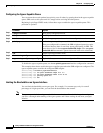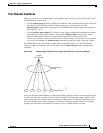
30-3
Catalyst 2960 Switch Software Configuration Guide
78-16881-01
Chapter 30 Configuring EtherChannels
Understanding EtherChannels
Port-Channel Interfaces
When you create a Layer 2 EtherChannel, a port-channel logical interface is involved. You can create
the EtherChannel in these ways:
• Use the channel-group interface configuration command. This command automatically creates the
port-channel logical interface when the channel group gets its first physical port. The
channel-group command binds the physical (10/100/1000 ports) and the logical ports together as
shown in Figure 30-2.
• Use the interface port-channel port-channel-number global configuration command to manually
create the port-channel logical interface. Then use the channel-group channel-group-number
interface configuration command to bind the logical interface to a physical port. The
channel-group-number can be the same as the port-channel-number, or you can use a new number.
If you use a new number, the channel-group command dynamically creates a new port channel.
Each EtherChannel has a port-channel logical interface numbered from 1 to 6. This port-channel
interface number corresponds to the one specified with the channel-group interface configuration
command.
Figure 30-2 Relationship of Physical Ports, Logical Port Channels, and Channel Groups
After you configure an EtherChannel, configuration changes applied to the port-channel interface apply
to all the physical ports assigned to the port-channel interface. Configuration changes applied to the
physical port affect only the port where you apply the configuration. To change the parameters of all
ports in an EtherChannel, apply configuration commands to the port-channel interface, for example,
spanning-tree commands or commands to configure a Layer 2 EtherChannel as a trunk.
101238
Channel-group
binding
Physical ports
Logical
port-channel


















